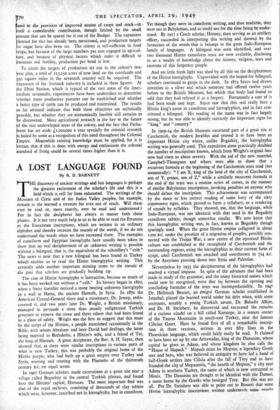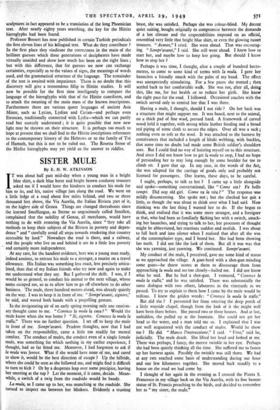A LOST LANGUAGE FOUND
By R. D. BARNETT
THE discovery of ancient writings and lost languages is perhaps the greatest excitement of the scholar's life and this is a field which is still far from exhausted. The writings of the Minoans of Crete and of the Indus Valley peoples, for example, remain to the learned a treasure for ever out of reach. Will these ever be read or, more exactly, ever be read and understood ? For in fact the decipherer has always to master both these phases. It is not very much help to us to be able to read the Etruscan or the Eteocretan inscriptions, which are written in an ordinary alphabet and thereby recreate the sounds of the words, if we do not understand the words when we have recreated them. The examples of cuneiform and Egyptian hieroglyphs have usually been taken to show that no real decipherment of an unknown writing is possible without a bilingual, that is, the equivalent of the schoolboy's "crib." The news is now that a new bilingual has been found in Turkey which enables us to read the Hittite hieroglyphic writing. This certainly adds another important missing stone to the mosaic of the past that scholars are gradually building up.
The case of Hittite hieroglyphs is instructive, because so much of it has been worked out without a " crib." Its history began in 1812, when a Swiss traveller noticed a stone bearing unknown hieroglyphs in a wall at Hama, the ancient Hamath, in Syria. In 187o the American Consul-General there and a missionary, Dr. Jessop, redis- covered it, and two years later Dr. Wright, a British missionary, managed to persuade a more than usually enlightened Turkish governor to remove the stone and three others that had been found to a place of safety. Wright was the first to suggest that this must be the script of the Hittites, a people mentioned occasionally in the Bible, with whom Abraham and later David had dealings, the latter being married to Bathsheba, a Hittite's wife, and a friend of Toi, the king of Hamath. A great decipherer, the Rev. A. H. Sayce, then showed that, as there were similar inscriptions in various parts of what is now Turkey, this was probably the original home of the Hittite people, who had built up a great empire over Turkey and Syria, warring and treating with the Pharaohs of the thirteenth century B.C. on equal terms.
In 1907 German scholars made excavations at a great site near a village called Bogazkoy in the central Turkish plateau, and found here the Hittites' capital, Hattusas. The most important fmd was that of the royal archives, consisting of thousands of clay tablets which were, however, inscribed not in hieroglyphs, but in cuneiform. Yet though they were in cuneiform writing, and thus readable, they were not in Babylonian, and so could not for the time being be under- stood. By 1917 a Czech scholar, Hrozny, then serving as an artillery officer, succeeded in interpreting this writing and showed by the formation of the words that it belongs to the great Indo-European family of languages. A bilingual was soon identified, and over two thousand Hittite cuneiform texts are now available, disclosing to us a wealth of knowledge about the history, religion, laws and customs of this forgotten people.
And yet little fresh light was shed by all this on the decipherment of the Hittite hieroglyphs. Unprovided with the hoped-for bilingual, scholars continued to grope in the dark. In 1872 Sayce had drawn attention to a silver seal which someone had offered twelve years before to the British Museum, but which that body had found so odd that they had refused it as a forgery. Fortunately a cast of it had been made and kept. Sayce saw that this seal really bore a Hittite king's name in cuneiform and hieroglyphics, and in fact con- stituted a bilingual. His reading of the name was in fact largely wrong, but he was able to identify correctly the important signs for " king " and " country."
In 1909-14 the British Museum excavated part of a great site at Carchemish, the modern Jerablus and proved it to have been an important Hittite city where, unlike Bogazkay, the hieroglyphic writing was generally used. This expedition alone practically doubled the number of inscriptions known, which from Wright's original four now had risen to about seventy. With the aid of the new material, Campbell-Thompson and others were able to show that a recurrent formula at the beginning of the Carchemish texts read (not unnaturally): " I am X, king of the land of the city of Carchemish, son of Y, prince, son of Z," while a similarly recurrent formula at the end of the texts was a routine series of curses, in the manner of similar Babylonian inscriptions, invoking penalties on anyone who should deface the inscription. This achievement was accompanied by the more or less correct reading of some forty of the sixty commonest signs, which proved to form a syllabary, or a rendering of sounds by syllables. They showed, too, that the language, while Indo-European, was not identical with that used in the Bogazkoy cuneiform tablets, though somewhat similar. We now know that this hieroglyphic writing was, in fact, known at Bogazkoy though sparingly used. When the great Hittite empire collapsed in about 1200 B.C. under the presSine of a migration of peoples, possibly con- nected with the Trojan War, a new centre of the uprooted Hittite culture was established at the stronghold of Carchemish and the surrounding regions, using the hieroglyphics as their current form of script, until Carchemish was attacked and overthrown in 714 B.C. by the Assyrians pressing down into Syria and Palestine.
Nevertheless by 1935 the decipherment of the hieroglyphics had reached a virtual impasse. In spite of the advances that had been made in study of the grammar, and the many historical names which could now be recognised, most that lay between the opening and concluding formulae of the texts was incomprehensible. In 1947 Dr. Hellmuth Bossert, an emigré German scholar established in Istanbul, placed the learned world under his debt when, with some assistants, notably a young Turkish savant, Dr. Bahadir Alkim, and Dr. H. Steinherr, he discovered and excavated the remains of a curious citadel on a hill called Karatepe, in a remote corner of the Taurus Mountains in south-east Turkey, near the famous Cilician Gates. Here he found first of all a remarkable inscrip- tion in three versions, written in over fifty lines in the Phoenician language, which could fairly easily be read. It claimed to have been set up by one Azitawadas, king of the Danunim, whose capital he gives as Adam, and whose kingdom he also calls the " House of Mapash." Mapash must be Mopsus, a legendary Greek seer and hero, who was believed in antiquity to have led a band of half-Greek settlers into -Cilicia after the fall of Troy and to have founded the city of Mopsuestia, " the hearth of Mopsus," a city near Adana in southern Turkey, the name of which is now corrupted to Missis. The Danunim are thought to be identical with the Danaoi, a name borne by the Greeks who besieged Troy. But this was not all. For Dr. Steinherr was able to point out to Bossert that some Hittite hieroglyphic inscriptions written underneath some nearby
sculptures in fact appeared to be a translation of the long Phoenician text. After nearly eighty years searching, the key for the Hittite hieroglyphs had been found.
Professor Bossert has now published in certain Turkish periodicals the first eleven lines of his bilingual text. What do they contribute ? In the first place they vindicate the correctness in the main of the brilliant guesses which three generations of decipherers have made virtually unaided and show how much has been on the right lines ; but with this difference, that for guesses we now can exchange certainties, especially as to the values of signs, the meanings of words used, and the grammatical structure of the language. The remainder of the text is awaited with impatience. There is no doubt that this discovery will give a tremendous fillip to Hittite studies. It will now be possible for the first time intelligently to compare the language of the hieroglyphs with that of the Hittite cuneiform, and to attack the meaning of the main mass of the known inscriptions. Furthermore there are various queer languages of ancient Asia Minor, such as Lycian, Lydian and Carian—and perhaps even Etruscan, traditionally connected with Lydia—which we can partly read but scarcely understand ; it is quite possible that now new light may be thrown on their structure. It is perhaps too much to hope at present that we shall find in the Hittite inscriptions references to the contemporary history of the Hebrews or to the family of Toi of Hamath, but this is not to be ruled out. The Rosetta Stone of the Hittite hieroglyphs may yet yield us the answer to riddles.



































 Previous page
Previous page